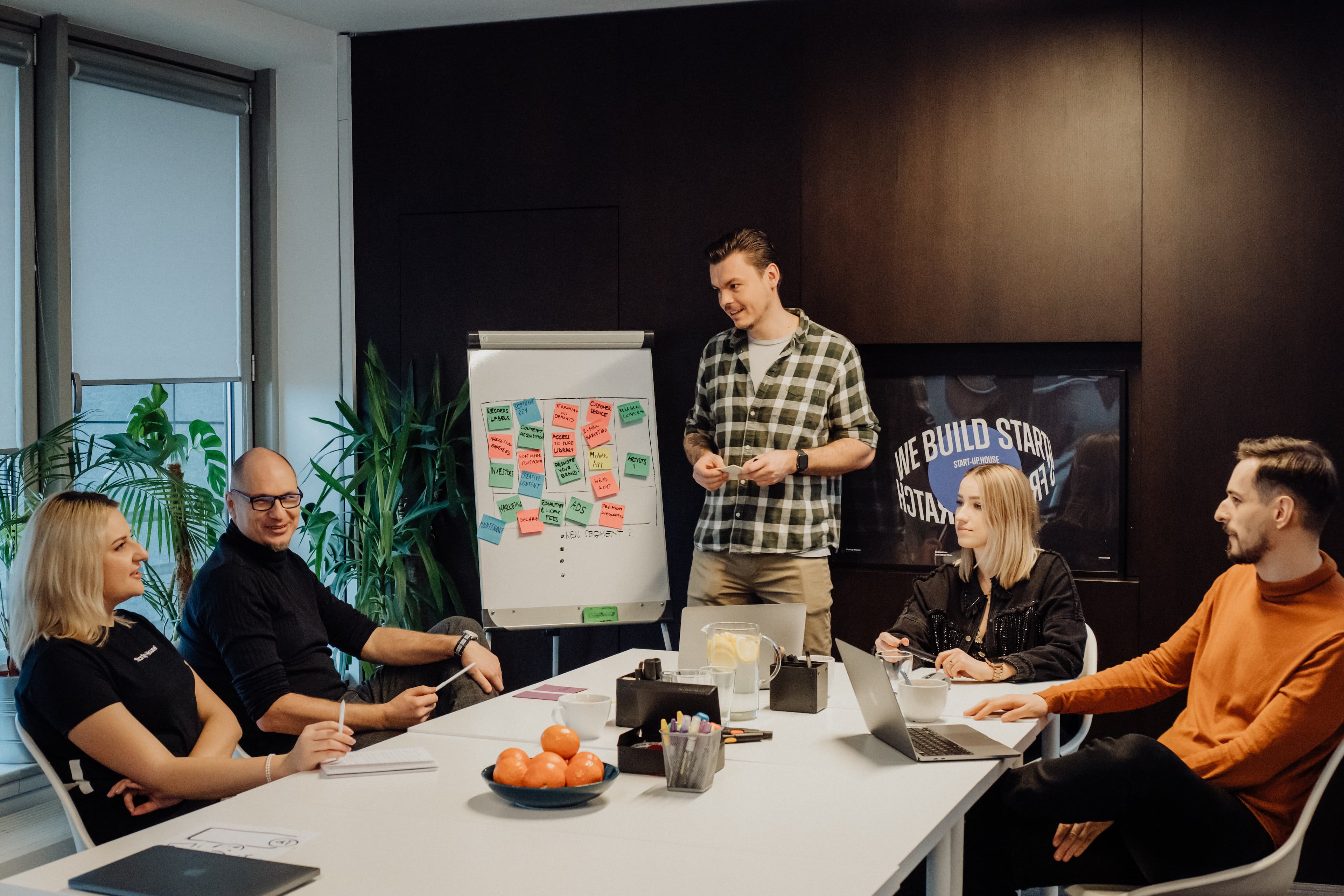Best Free or Premium Headless Content Management Systems (CMS)
Marek Majdak
Apr 07, 2023・5 min read
Table of Content
Why Do You Need a Headless CMS?
Headless CMS vs. Traditional CMS Comparison
How Does a Headless CMS Work?
Top Systems for Headless Content Management in 2023
Contentful
Sanity
Strapi
How Composable Architecture Can Get You Where You Want to Go
How Does a Headless CMS Solution Work?
Manage content for more channels
Content Reusability
Streamlined Workflow
Quick Adaptation to New Channels
CMS Confronts Multifaceted Digital Content Consumption
What is the Difference Between a Headless CMS and a Decoupled CMS?
Best Practices to Setting up Headless CMS Solutions
Use Cases for Headless CMS
How Does Headless CMS Architecture Work?
Conclusions
FAQs
The shift towards headless content management systems is becoming more pronounced. Traditional CMS setups are giving way to more agile, efficient, and scalable solutions. But what is a headless CMS and how does it cater to contemporary content management needs? In this comprehensive guide, we will delve deep to answer this and many other pertinent questions, emphasizing the various keywords outlined.
Why Do You Need a Headless CMS?
In an age where content consumption happens across multiple platforms and digital channels, the need for a headless CMS becomes apparent. Unlike a traditional content management system, a headless CMS allows for greater flexibility in content presentation and distribution across different digital channels, from websites to mobile apps. Moreover, content editors find it easier to manage content without being burdened by the frontend presentation layer, often attached to traditional CMS platforms.
Headless CMS vs. Traditional CMS Comparison
Headless CMS:
- Separates the content repository from the presentation layer, allowing for seamless content delivery to multiple channels.
- Gives complete control over the frontend presentation layer, offering a fully custom editor experience.
- Facilitates streamlined content collaboration and personalized content creation across digital platforms.
Traditional CMS:
- Tightly connected to the presentation layer, restricting content delivery to predefined templates.
- Offers lesser flexibility in content presentation and might not automatically adapt to new channels like smart devices.
- Often less suited for content editors looking to deliver content swiftly across a plethora of digital channels.
How Does a Headless CMS Work?
A headless CMS works by storing the digital content in a content repository, ready to be displayed on various platforms through API calls. Here, we dissect its workings step by step:
- Content Creation: Content editors use tools within the CMS to create structured content. This process includes utilizing personalization tools to craft content that resonates with the target audience.
- Content Storage: Once created, the content is stored in a database, ready to be fetched for display on multiple platforms, including ecommerce platforms and mobile apps.
- Content Delivery: Utilizing RESTful API, the headless CMS delivers content dynamically to various digital touchpoints, ensuring a uniform digital experience.
Top Systems for Headless Content Management in 2023
In 2023, several systems have emerged as leaders in the headless content management sphere, carving out a niche for themselves with distinctive features and offerings. Leveraging these top systems for headless content management can provide businesses with the agility and flexibility they need to thrive in a digitally-driven landscape. Here, we dive deep into the attributes of these top-notch headless CMS solutions:
Contentful
A popular choice among businesses, Contentful stands tall as a formidable player in the headless content management systems landscape. Here are some reasons why many opt for Contentful:
- Scalability: Offers the ability to scale your digital experiences seamlessly, catering to both small and large enterprises.
- Developer Support: Provides excellent developer support, aiding in smooth integration and deployment of content across various digital platforms.
- Rich Feature Set: Equipped with a myriad of features such as content collaboration and workflow management, it facilitates a streamlined content creation and distribution process.
- Personalized Content Delivery: Utilizes personalization tools to deliver tailored content across various digital touchpoints, enhancing user engagement and satisfaction.
Sanity
Sanity has garnered the attention of big companies, cementing its position as a top-tier headless content management system. Here are the reasons why big companies choose Sanity:
- Fully Custom Editor: Offers a fully custom editor that allows for a personalized and streamlined content editing experience, catering to both technical and non-technical users.
- Comprehensive Content Infrastructure: Possesses a comprehensive content infrastructure that facilitates easy content housed and management, catering to diverse business needs.
- Real-time Collaboration: Enables real-time content collaboration, allowing teams to work cohesively and efficiently.
- Multi-Platform Support: Supports multiple platforms, allowing for the efficient distribution of content across various channels, including mobile apps and ecommerce platforms.
Strapi
Strapi has emerged as a reliable open-source solution, popular for its API-first CMS approach. Here’s why it is one of the top systems for headless content management:
- API-First CMS: Strapi's API-first CMS approach facilitates seamless content collaboration and management, offering a robust platform for content delivery and integration.
- Developer-Friendly: Offers a developer-friendly environment, providing the necessary tools and support to create and manage digital content effectively.
- Community Support: Being open-source, it enjoys a vibrant community support that continually works to enhance its features and functionalities.
- Cross-Channel Content Management: Facilitates easy management of content across multiple channels, aiding businesses in maintaining a cohesive brand presence across all digital channels.
It's imperative to note that the headless CMS landscape is evolving, and new players are continuously entering the market.
How Composable Architecture Can Get You Where You Want to Go
Implementing a composable architecture in your headless CMS solution can offer numerous benefits:
- Flexibility: Tailor your content management system to your specific needs, seamlessly integrating various digital experiences and tools.
- Scalability: A composable architecture allows for scaling your content management efforts according to business growth, efficiently managing content across digital channels.
- Innovation: Encourages innovation by allowing businesses to test and implement new channels and technologies without disrupting the existing content management workflow.
How Does a Headless CMS Solution Work?
Understanding how a headless CMS solution works is essential in leveraging its full potential. Below are the main components that outline how it functions:
- Content Repository: This is where all the content is housed, facilitating easy access and reuse of content across different platforms.
- APIs: APIs play a critical role in a headless CMS solution, enabling the delivery and display of content across various digital touchpoints, including mobile apps and ecommerce platforms.
- Frontend Development: With a headless CMS solution, businesses have complete control over the frontend development, allowing for a fully custom editor experience and content presentation optimized for each digital channel.
Manage content for more channels
Let us delve deeper into how a headless CMS acts as a beacon in managing content across multiple platforms:
Content Reusability
A prominent feature of headless CMS solutions is the facilitation of content reusability, a quintessential aspect in today's digital content landscape. Here's why content reusability is vital:
- Cost-Efficiency: By eliminating the necessity to create distinct content for each channel, businesses can significantly reduce costs and enhance efficiency.
- Consistency: Maintaining a consistent brand message becomes seamless as the same content can be deployed across various platforms without any alteration.
- Time-Saving: It saves time and effort as content editors can focus on creating high-quality content that can be reused across multiple channels, instead of duplicating efforts.
Streamlined Workflow
Streamlining workflow is another significant advantage brought about by adopting headless CMS solutions. Here are the benefits it bestows:
- Centralized Management: It centralizes content management, enabling a unified view and control over the content repository, thereby enhancing organizational efficiency and productivity.
- Collaborative Environment: Creates a conducive environment for content collaboration, fostering unity and seamless cooperation among teams.
- Automated Processes: The headless content management system can automate various processes, simplifying workflow management and reducing manual efforts.
Quick Adaptation to New Channels
The digital landscape is constantly evolving, introducing new channels at a brisk pace. Headless CMS solutions ensure that businesses can swiftly adapt to these changes. Here's how:
- Agile Response: Headless CMS offers agility in responding to new channel opportunities, helping businesses to stay a step ahead in the dynamic digital marketplace.
- Integration Capabilities: Equipped with robust integration capabilities, it facilitates the easy incorporation of new channels into the existing content infrastructure.
- Competitive Advantage: By allowing for quick adaptation to new channels, it provides businesses with a competitive edge, helping them capitalize on emerging opportunities in the digital space.
CMS Confronts Multifaceted Digital Content Consumption
As we venture deeper into the digital age, the way users consume content has undergone significant changes. A headless CMS is crafted to meet the demands of multifaceted digital content consumption. Here's how:
- Responsive Content Delivery: A headless content management system ensures that digital content is formatted correctly across all platforms, providing a unified user experience across mobile apps, smart devices, and various other digital channels.
- Personalized Content Experience: Leveraging analytics and personalization tools, a headless CMS offers personalized content to different segments of the audience, enhancing user engagement.
- Facilitating Content Editors: A headless CMS simplifies the content creation process, offering content editors a hassle-free environment to create and manage content, ready to be displayed across multiple platforms.
What is the Difference Between a Headless CMS and a Decoupled CMS?
Understanding the nuances between a headless CMS and a decoupled CMS is crucial in choosing the right CMS solution. Here we elucidate the differences:
- Headless CMS: A pure headless CMS operates with no frontend presentation layer attached, focusing solely on backend content management, facilitating seamless content delivery to various digital channels via APIs.
- Decoupled CMS: A decoupled CMS, on the other hand, maintains a separate but connected frontend presentation layer, allowing for more control over content presentation while still offering the flexibility to deliver content to various channels.
Best Practices to Setting up Headless CMS Solutions
Setting up a headless CMS necessitates adherence to certain best practices to optimize its functionality. Here are some guidelines:
- Structured Content Management: Implement structured data models to facilitate easier content management and delivery across multiple channels.
- SEO Optimization: Focus on SEO elements like meta tags and structured data to enhance the visibility of your digital content on search engines.
- User-Friendly Editor Interface: Provide a fully custom editor interface to facilitate non-technical users in managing content seamlessly.
Use Cases for Headless CMS
Headless CMS solutions find applications in various domains. Some prominent use cases include:
- E-Commerce Platforms: Integrating headless CMS with ecommerce platforms to manage and deliver content efficiently to enhance user experiences.
- Mobile Apps: Utilizing headless CMS solutions to streamline content management for mobile apps, ensuring consistency in content delivery across platforms.
- Digital Signage: Leveraging headless CMS solutions for managing digital content on digital signage, ensuring real-time updates and personalized content delivery.
How Does Headless CMS Architecture Work?
The headless CMS architecture is built to streamline content management and delivery processes. It operates through the following components:
- Content Repository: A centralized database where all the content is stored, ready to be fetched and displayed across various digital platforms.
- APIs: APIs facilitate the seamless transfer of content from the content repository to different digital channels, ensuring uniform content presentation.
- Frontend Development: Headless CMS architecture allows businesses to have complete control over frontend development, optimizing content presentation for each specific channel.
Conclusions
Headless content management systems emerge as a potent tool that promises agility, flexibility, and efficiency. Businesses, from startups to big enterprises, are increasingly adopting headless CMS solutions to manage content across a diverse range of digital channels and platforms, ensuring uniformity and seamless content delivery. As you venture into implementing or transitioning to a headless CMS, considering factors such as scalability, content reusability, and streamlined workflow management can guide you to make an informed decision. The time is ripe to embrace the headless CMS trend and steer your business towards a digitally progressive future.
FAQs
- What is a headless CMS? A headless CMS is a content management system that separates the backend content repository from the frontend presentation layer, allowing for content to be published across multiple platforms and digital channels seamlessly.
- How is headless CMS different from traditional CMS? Unlike traditional CMS, headless CMS does not have a frontend presentation layer attached, which allows for more flexibility in content presentation across various digital channels. Traditional CMS is more rigid, with the content and presentation layers being tightly connected.
- What are the main benefits of using a headless CMS? The primary benefits of using a headless CMS include greater flexibility, improved workflow management, easy content reuse across multiple channels, and the ability to quickly adapt to new digital platforms.
- Can a headless CMS solution improve content delivery? Yes, a headless CMS solution can significantly enhance content delivery by allowing for content to be tailored and automatically adapted for various digital channels and platforms, providing a cohesive and personalized content experience for users.
- Why should big companies choose Sanity as their headless CMS? Big companies often choose Sanity because it offers a fully custom editor, robust content infrastructure, and facilitates easy content editing and management, catering to complex content strategies and digital experiences.
- How does a headless CMS facilitate content management for multiple channels? A headless CMS facilitates content management for multiple channels by allowing content to be created and stored in a way that can be easily distributed and displayed across various digital touchpoints, ensuring consistency and quality.
- What are some top systems for headless content management in 2023? Some of the top systems for headless content management in 2023 include Contentful, Sanity, and Strapi, each offering a rich set of features and functionalities tailored to modern digital content requirements.
- Is a headless CMS more secure than a traditional CMS? A headless CMS can potentially offer better security compared to traditional CMS, as the separation of content and presentation layers can reduce the vulnerability to certain types of cyber-attacks, such as cross-site scripting.
- How does AWS support headless CMS requirements? AWS supports headless CMS requirements by providing a scalable, reliable, and secure infrastructure where the content can be hosted and managed effectively, coupled with tools and services that facilitate efficient content delivery and management.
- What are the primary features of a decoupled CMS? A decoupled CMS, similar to a headless CMS, separates the content repository from the presentation layer, but retains a connection to a specific frontend, offering a balance between flexibility and control over content presentation.
- Can non-technical users easily adapt to using a headless CMS? Yes, many headless CMS platforms are designed to be user-friendly, offering intuitive interfaces and features that facilitate easy content creation and management, even for non-technical users.
- What role does API play in a headless CMS architecture? In a headless CMS architecture, APIs (Application Programming Interfaces) play a crucial role in facilitating the seamless transfer of content between the content repository and various frontend platforms, enabling dynamic content delivery and presentation.
- How does a headless CMS enhance content collaboration? A headless CMS enhances content collaboration by providing centralized content repositories and collaboration tools that allow teams to work together more effectively, streamlining content creation and distribution processes.
- What are some best practices to set up headless CMS solutions? Best practices to set up headless CMS solutions include planning a structured data model, considering the scalability of the CMS, implementing effective workflow management strategies, and ensuring security and compliance standards are met.
- How do headless CMS solutions impact mobile apps? Headless CMS solutions have a positive impact on mobile apps by allowing for a more streamlined and consistent content delivery, enhancing the user experience by presenting content optimally across various mobile platforms.
- What are some common use cases for headless CMS? Common use cases for headless CMS include eCommerce platforms, corporate websites, mobile apps, digital signage applications, and content delivery for smart devices, among others.
- Can headless CMS solutions facilitate personalized content delivery? Yes, headless CMS solutions can facilitate personalized content delivery by allowing for the integration of personalization tools that can tailor content based on user preferences and behavior, enhancing user engagement and satisfaction.
- How do I choose the right headless CMS? Choosing the right headless CMS involves considering factors such as the specific needs of your business, the scalability of the CMS, the features it offers, its compatibility with your existing systems, and the level of support and documentation available.
- Are there free or premium headless CMS solutions available? Yes, there are both free and premium headless CMS solutions available, catering to different budget and functionality requirements. It is advisable to conduct a thorough analysis to determine the best headless CMS that meets your business objectives.
- Why is content reusability an important feature of headless CMS? Content reusability is a crucial feature of headless CMS as it allows for the creation of content that can be used across multiple platforms and channels, saving time and resources, and ensuring a cohesive and consistent brand message across the digital landscape.
Digital Transformation Strategy for Siemens Finance
Cloud-based platform for Siemens Financial Services in Poland


You may also like...

Top Traits of an Outstanding Software Development Team
The success of any software project depends on the team. See the top traits that turn good dev teams into outstanding ones.
Alexander Stasiak
Apr 18, 2025・12 min read

Choosing the Right Software Development Partner: A Practical Guide for Startups
The right software development partner can define your startup’s success. This guide shows how to choose one that fits your goals and needs.
Alexander Stasiak
Dec 30, 2024・10 min read

Understanding Event-Driven Programming: A Simple Guide for Everyone
Explore the essentials of event-driven programming. Learn how this responsive paradigm powers interactive applications with real-world examples and key concepts.
Marek Pałys
Apr 30, 2024・9 min read




